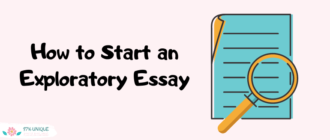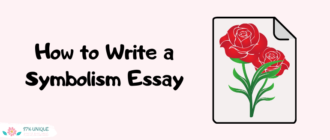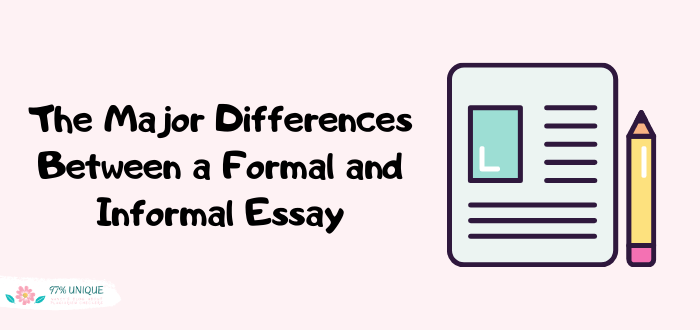
Whether you are writing an essay for an upcoming assignment, in the process of writing a dissertation, or simply writing an email to a colleague, it’s important to keep one thing in mind in order to determine the direction your writing will go – to whom am I writing to?
After spending several years in the classroom as a secondary teacher and sifting through an endless supply of online educational forums, I’ve learned how to masterfully differentiate my writing depending on the given task at hand.
You can too.
If you’re a newbie when it comes to writing, trying to expand your knowledge, or just suffering from a really bad case of colygraphia (I bet you didn’t know that means writer’s block), reading this article will give you a better understanding of what are the major differences between a formal and informal essay and give you tips to become a better writer.
Without further ado, let’s jump right in!
What Are the Major Differences Between a Formal and Informal Essay?
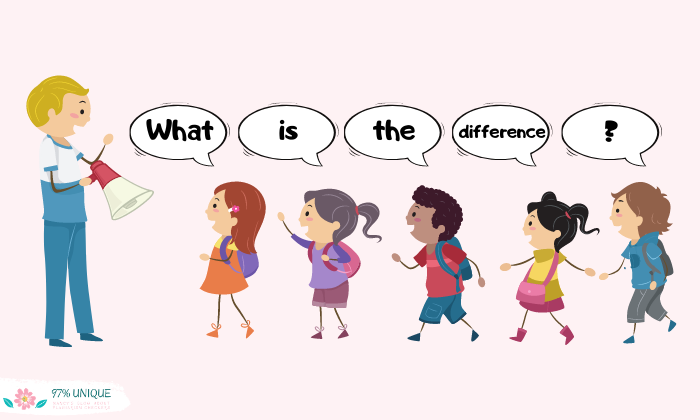
The amount of times I’ve been asked the question, “Are formal and informal writing the same?” by my students is likely close to infinity at this point, so maybe putting it in writing will eliminate the question once and for all (probably not, but I can dream).
To start understanding the difference between formal and informal essay let’s focus on formal essays first.
What Is a Formal Essay?

A formal essay is a piece of writing that is used to inform or persuade your intended audience. Unlike a personal or narrative essay, formal essays tend to be more objective because they revolve around provable facts and examples.
Where Is It Typically Used?
Although most people think of secondary school when they hear the words ‘formal essay’, it has several purposes outside of academics; such as job applications, writing to a client, or reaching out to someone you don’t know.
Viewpoint
Formal essays are often written in third person (e.g. he, his, him, himself, her, she, hers, it, its, itself, them, they, their, theirs, and themselves).
Tone
The tone should be objective, with little to no emotional input.
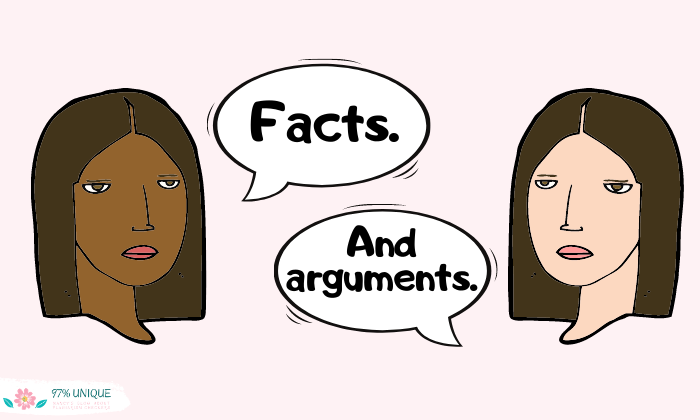
Ideas or perspectives are expressed with unbiased facts and powerful arguments rather than feelings or personal opinions.
Structure
Formal essays are outlined in a way that focuses on one clear argument or idea at a time which supports the thesis. A typical academic formal essay is set up in the following manner: introduction (2-4 sentences), body (2-3 paragraphs), and conclusion (2-4 sentences).
Vocabulary
Use proper English with technical words related to the subject. Avoid the use of “I” and “you” (although these words can sometimes be used in an introduction or conclusion).
If you are struggling to wrap your head around the language used in formal writing, check out this short video by Smrt English that highlights the differences between formal and informal language and which style is most appropriate for formal writing.
Also, don’t forget to use proper punctuation and correct spacing between paragraphs.
Purpose
Usually used to present facts and ideas from a critical point of view by analyzing the subject in detail or through argumentative dialogue.
Length
The length is dependent on how long it takes to get your point across, but typically the body of a formal essay goes as follows: introduction, examples, explanation, conclusion tied to the thesis, and transition when necessary. However, if you are one of my middle/high school students, the answer is always FIVE PARAGRAPHS.
5 Tips to Writing a Strong Formal Essay
- Keep your feelings out of it. Formal essays are objective and professional, so talking about how much you love or hate something should be left out altogether.
- Organize your thoughts in advance by planning. Sure, it may take you more time to complete the essay if you spend time planning first, but being able to coherently express ideas requires careful attention to detail.
- Use a plagiarism checker to make sure you don’t accidentally cheat or incorrectly cite sources. If you need a reliable method to ensure your content is 100% original, click here to find out more.
- Read your paper out loud while editing/revising. You’d be surprised how differently sentences sound in your head compared to when you physically hear it.
- Get ideas from peers on how to better structure your writing or just read this article about how to write a formal essay.
In need of a hands-on video that goes over the do’s and don’ts of writing an informative essay? Check out this video by EssayPro once you’ve finished here.
Now that we have formal essays under control, it’s time to move on to informal essays.
What Is an Informal Essay?

An informal essay is not as strict as a formal essay when it comes to formatting and the language used; instead, it’s written in a more conversational style. Informal essays can still be informative or reflect a certain perspective effectively, it’s just more loosely written.
Where Is It Typically Used?
Whether it is used to express personal views, political opinions, or to organize ideas, informal essays are usually written for pleasure.
Viewpoint
Informal essays are often written in first-person (e.g. I, my, me, mine and myself) and sometimes second person (e.g. you, your, yours).
Tone
The tone tends to be more laid back and personal.
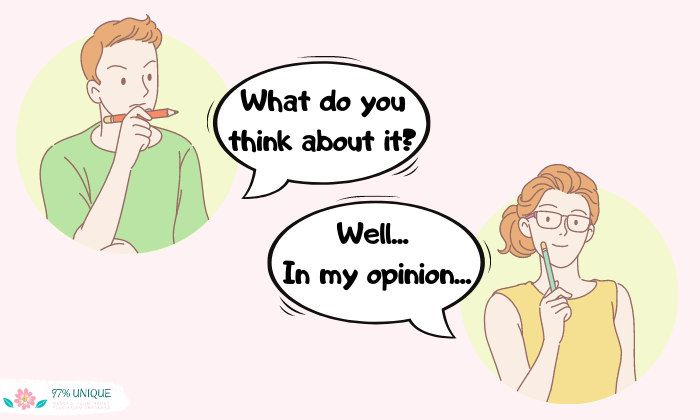
It can be amusing, ironic, serious, thoughtful or casual.
Structure
Unlike formal essays that have traditional outlines, informal essays can be laid out however the author chooses. Although informal essays can still follow a formal format in terms of structure, they tend to not be so rigid.
Vocabulary
Everyday words, contractions, and slang can be used in informal essays. Instead of saying, “To whom this may concern”, you can say, “Hey, this essay is for you, so you better pay attention.”
Still confused or not sure about what are the differences between a formal and informal essay in terms of language? Here’s a different video created by Learn Easy English which highlights the differences between the two and gives examples.
Although punctuation and grammar don’t technically have to be ‘perfect’, I recommend considering the audience before coming to a conclusion and how to move forward.
Purpose
Informal essays are for entertainment, reflection, or for responding to your crazy aunt’s biased opinions in a way that a text message simply can’t. Be sure to look for inspiration from other essays if you start suffering from colygraphia.
Length
FIVE PARAGRAPHS!…just kidding, informal essays can be as long or short as you want it to be. That’s almost the main difference between formal and informal essay.
5 Tips to Writing an Effective Informal Essay
- Show your personality in your writing. An effective way to write an informal essay is to approach it the same way you would a conversation.
- Use readable language. Don’t resort to a vernacular that is foreign to you, make it intelligible (see what I did there?).
- Write an outline to better organize your ideas before writing. An outline can be a bubble map, a list of concepts you want to express, or the order in which you want to present your ideas.
- Don’t be afraid to make grammatical mistakes! Remember, everyday language and slang are okay, so you won’t lose points for using ‘wadup’ or ‘that’s dope’ to express your ideas.
- Cater your medium to the intended audience. If your presenting to a group or pitching an idea, consider using PowerPoint instead of reading out an essay. Having a lover’s quarrel? A letter is likely more effective at expressing your feelings than through an essay or PowerPoint presentation (can you imagine?).
Speaking of PowerPoints, if you are a teacher grading classwork or a student trying to pass their work through Copyscape, click here to learn about the 4 best ways to check a PowerPoint presentation for plagiarism.
Let’s Wrap it Up
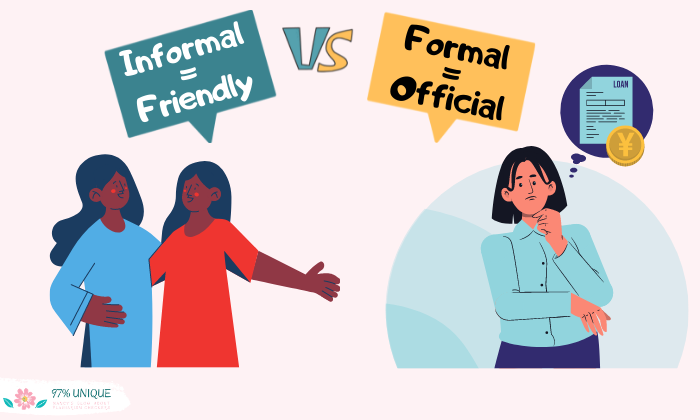
In order to understand what are the major differences between a formal and informal essay, you need to remember two words: friendly and official. If you aren’t able to figure out which word represents which type of essay immediately, please look at this graph to give yourself a visual.
Formal essays are official and informal essays are friendly.
Useful Resources
- The main types of essay
- Best way to write an essay in under 30 minutes
- Planning an essay
- Main 5 parts of an essay: easy guidelines for writers
Conclusion
Now that you have a clear understanding of the differences between the two, it’s time for the hard part: actually writing the essay. If you need free help rewriting sentences and verifying your essay is plagiarism-free, click here to learn more about Plagiarisma.



